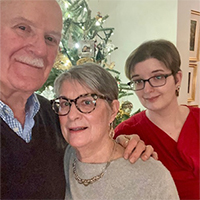A parent never wants to hear that their child might never learn to read or write.

That’s what specialists told Vivian after her daughter Emma’s first neurological assessment to address reading difficulties. A first-grade teacher at her progressive Quaker school called Vivian to explain that Emma seemed drastically different from the previous year and was displaying reading difficulties. Her parents had noticed the changes and were concerned as well. School was no longer fun for Emma; she was losing her enthusiasm.
“I went through this period of mourning that my bubbly, happy child was all of a sudden really disliking school and feeling very frustrated, becoming even more introverted than she already was,” Vivian said.
Pursuing Knowledge
When Emma was young, parents weren’t often encouraged to seek neurological diagnoses for their struggling readers. The prevailing opinion at the time was that children developed reading skills on their own timelines and at different rates, so a diagnosis wasn’t necessary. This didn’t ring true in Emma’s case.
“We said, ‘We need to know more,’” Vivian explained. “We started down the medical journey, which was great because, in a sense, we began to discover what we were dealing with.”
Vivian knew that investigating the cause of Emma’s struggle was worth the effort. After many discussions with the family’s health insurer, Emma was assessed in the fall of 1999 and diagnosed with dyslexia.
That winter, Vivian took Emma to the pediatric neurology clinic at a large public university for further assessments. When one of Vivian’s colleagues suggested that Emma may have central auditory processing disorder, Emma’s family sought the help of the university’s audiology department in the spring. After comprehensive neuropsychological and audiological assessments, Emma was diagnosed with not only dyslexia but also severe central auditory processing disorder and the inability to cross her midline (meaning the two sides of her brain weren’t communicating with each other). There also was a discrepancy between her reading disability and her intelligence, which was not in deficit.
Central auditory processing disorder makes reading challenging because the brain processes sounds so slowly that it misunderstands them. For instance, “book in a bag” could be misheard as “look in the tag.” When an individual can’t process sounds quickly, they can’t easily connect those sounds to letters, which makes decoding nearly impossible.
While it was helpful to know what specific issues Emma struggled with, her parents didn’t accept the specialist’s opinion that she might never learn to read or write. Vivian and her husband sought more information and interventions to help their daughter learn to read to the best of her potential.
“My husband said, ‘We’ll treat her like an athlete and take her to whatever level she can reach. We won’t say we know what the limit is,’” Vivian shared.
At first, Emma tried computer phonics programs and worked with a reading tutor. Her parents felt the tutor didn’t provide rigorous enough instruction for Emma. Several interventions they tried were not a good fit; others were not possible because they required the family to move. By the end of second grade, Emma was still struggling to read. Her mother knew it was time to seek another educational setting. That was when she discovered a school for neurodiverse students and those with learning disabilities. The school was implementing the Wilson Reading System® (WRS) for Structured Literacy (SL) instruction. In addition to receiving WRS instruction, Emma also visited a pediatric neurology clinic for help with central auditory processing and physical therapy to practice crossing the midline for handwriting.
Vivian and her husband learned as much as they could about Emma’s struggles. “I like to understand what I’m dealing with,” Vivian said. “So much information frames dyslexia and central auditory processing disorder as deficits. I had to change my mindset. I had to start with all the things she was good at.”
Hungry to Learn
While Emma received WRS instruction, her parents encouraged her to pursue her interests and nurtured her love of stories. She first decided she wanted to write creatively at seven years old.
“This was a kid who was hungry to learn,” Vivian emphasized.
Emma used assistive technologies to keep up with schoolwork. She learned to fence, create pottery, and ride horses to develop physical coordination. She became the state champion foil fencer in her senior year of high school.
Because she loved stories, Emma dictated some of her own stories to her parents, who wrote them down for her. Her parents also introduced her to audiobooks so she could enjoy tales written far above her reading level.
“Emma had the desire to be able to learn from books by herself, which I think was her biggest motivation. If she was interested in trains, horses, or fencing, we would find stuff that would inform her about that topic,” Vivian said. “If she couldn’t read it, we’d figure out a way for her to access it. What I gleaned from my research helped me decide that I wasn’t going to restrict content because she couldn’t decode.”
Central auditory processing disorder made it a challenge to master phonemes (the smallest units of sound in words) and connect them to graphemes (the smallest units of written language). With treatment for both her central auditory processing disorder and physical coordination issues, combined with the motivation to learn to read, Emma worked hard at her WRS lessons and began to thrive.
“Tapping out sounds was painful to watch at first,” Emma’s mother noted. Tapping is a technique used in Wilson programs to help students break down words and sounds into their smallest parts. After breaking down the word or sound by tapping their fingers to their thumb, they blend the sounds by running their thumb along their fingers. The tapping technique helps learners analyze and segment words into phonemes. Central auditory processing disorder and physical coordination issues caused by difficulty crossing the midline made tapping out sounds a challenge. “When she tried to do the blend motion, it was like she physically couldn‘t do it. But when she improved that skill, her reading fluency improved.”
Beyond Expectations
At the end of fifth grade, administrators from Emma’s school told Vivian that “…there is really nothing more we can do for Emma. She is a huge success story.”
Emma was reading fluently with confidence and no longer needed intensive instruction to decode and encode. She returned to the Quaker school she loved and studied at grade level with her peers.
With literacy success under her belt, Emma was accepted into an academically rigorous high school and began writing every day. During her junior year, she wrote a novel as part of an independent study project. She self-published the book and her school arranged a book signing to celebrate the accomplishment. Emma shared her bewilderment when peers asked her to explain why she thought she could write a novel. It never occurred to her that she shouldn’t try.
Emma’s successes didn’t end with that first self-published novel. She earned a BA in film from a highly selective college and a Master of Fine Arts in creative writing. She’s now working as the youngest editor of a professional journal. She’s also an agented novelist and has published numerous short stories and poems.
Congratulations on your hard-earned success, Emma!

